Complete Solutions to EXERCISE of chapter REPRODUCTION IN ORGANISM of Class 12 book with complete answers and questions
| Class 12 | BIOLOGY |
| Chapter | REPRODUCTION IN ORGANISM |
| MAXIMUM PUBLICATION | EXERCISE |
| Number Of Questions | 100 |
| Academic Year | 2023-24 |
Syngamy means:
00:49View SolutionFill in the blanks by observing the realtionship of the first.
01:41View SolutionInternal buds of sponges are:
01:14View SolutionIn honeybees and lizards the female gamete undergoes development to form new organism without fertilization. Name this phenomenon.
01:42View SolutionThe life span of man is ___ years.
00:27View SolutionWhat is meiocyte?
00:40View SolutionAll individuals produced are genetically identical
02:40View SolutionHydra reproduces asexually by
02:42View SolutionFind the propagules of ginger
01:26View SolutionBlub acts as a propagule in
01:21View SolutionIn some algae ___ are motile
02:13View SolutionA population of genetically identical plants derlved from a single parent is called……….
00:58View SolutionEmbryo sac is found in:
02:31View SolutionTypes of asexual reproduction found in Hydra is ….
01:26View SolutionObserve the relationship between the first two terms and fill in the blanks.
Pistils fused : syncarpous, Pistils free : ………03:16View SolutionIn honeybees and turkey new organisms are formed through a peculiar phenomenon. Name that phenomenon.
02:32View SolutionChosse the coorect answer : Chlamydomonas reproduces asexually through
01:02View SolutionIn Marchantia male and female thallus are separate. This condition is called
01:00View SolutionFind the odd one.
Bulbil,Bulb,Rhizome,Stem tuber00:41View SolutionIdentify the correctly matched pair.
01:00View SolutionSugar cane, Banana ,Ginger and Onion are following plants. But these are mostly cultivated by vegetative propagation.
What is meant by vegetative propagation.02:35View SolutionSugar cane, Banana ,Ginger and Onion are following plants. But these are mostly cultivated by vegetative propagation.
Can you identify which part of above plants are used for vegetative propagation.02:41View SolutionLeaves not only produce food but also produce young ones. Justify with one example.
02:24View SolutionHow is pistia and zingiber officinale diifferent in their mode of asexual reproduction?
02:20View SolutionFill in the blanks by observing the relationship of the first.
Male and female flowers on the same plant: monoecious
Male and female flowers on different plants : …………….02:11View SolutionFill in the blanks by observing the relationship of the first.
Fusion of gametes: Syngamy
Offspring from unfertilized female gamete : ……………….02:33View SolutionPlant can reproduce both vegetative and sexually. Name any 4 vegetative propagule.
04:52View SolutionGiven below is a diagram showing particular type of reproduction.
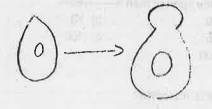
Name this process of reproduction.01:51View SolutionGiven below is a diagram showing particular type of reproduction.

Briefly explain the process.04:07View SolutionGiven below the figures of different types of reproduction present in organisms . Identify and name the type of reproduction.
 04:22View Solution
04:22View SolutionMatch the following:
(hint: Name of organisms in column A and asexual reproductive structures in column B)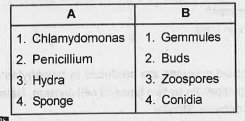 03:15View Solution
03:15View SolutionIn diploid Organisms , meiosis and gametogenesis are always interlinked.justify.
02:10View SolutionCategorize the following into pre and post fertilization changes in plants.
Gamete transfer,pericarp formation, ovule development, embryogenesis.02:25View SolutionEvents of sexual reproduction is given below.
Write the events in a sequential order.
Fertilization, gamete transfer, zygote,gametogenesis,embryogenesis.02:53View SolutionPoint out the difference between gametogenesis and embryogenesis.
02:25View SolutionWater-hyacinth is commonly called 'Terror of Bengal '.Give reason.
02:09View SolutionBamboo plant and strobilanthus kunthianus (Neela Kurunji) have similarity and dissimilarity in their reproductive and vegetative character. Justify.
01:52View SolutionZygote is called as the vital link.Why?
02:36View SolutionPost fertilization changes in plants are given, By observing the given pair complete the others.
a) Zygote : Embryo
b) Ovule : ……….
c) Ovary : ……….
d) Nucellus: Perisperm
e)Integuments : ……….
f) PEN : ……….01:59View SolutionLeaves are used not only for photosynthesis but also for reproduction.
a) Name the type of reproduction.
b) Give an example.01:46View SolutionObserve the relationship between first two terms and fill up the blanks.
Asexual reproduction-uniparental sexual reproduction…………………02:24View SolutionObserve the relationship between the first two terms and fill up the blanks
Zygote : Diploid nucleus
Endosperm : _________01:42View SolutionObserve the relationship betwwen first two trems and fill up the blanks.
Pea : non albuminous : wheat …………….03:42View SolutionIn yeast and Amoeba the parent cell divides to give rise to two individual cells. How does the cell division differ in these two organisms?
03:49View SolutionOffsprings formed due to sexual reproduction have better chances of survival.Why?
02:20View SolutionSome organism are capable of producing fertilized egg but others are not possible
a) Name the organism producing fertilized egg.
Why are offspring oviparous animals subjected to greater risk as compareed to offsprings of viviparous animals.03:04View SolutionIn one type plant Adventitious buds develops into new leafy shoot by leaf as means of vegetative propagation but in others by rhizome.Give an example for leaf and rhizome used as unit of vegetative propagation.
02:16View SolutionIn lower plants movement of gametes takes place by water but in seed plants male gametes are non motile. Which part helps the movement of gametes?
01:49View SolutionHaploid gametes are produced in bryophytes and angiosperms by two types of cell division. Name it.
02:04View SolutionSexual reproduction is very common in higher plants to produce young ones that shows variation.
a) Name the product formed in sexual reproduction in considered as vital link
b)Give its significance.02:08View SolutionNature prefer internal fertilization than external fertilization. Do you agree with this statements
03:49View SolutionIn fishes, gamete fusion takes place in external medium. Give the disadvantages of this method.
02:04View SolutionAnimals are categorized into viviparous and oviparous based on the development of the Zygote takes place outside the body or inside. In which of these two types the chances of survival is greater. Why?
01:53View SolutionMention the characteristic feature and a function of zoospore in some algae.
03:59View SolutionName the site of occurrence of syngamy in amphiibians and reptiles.
02:54View SolutionWhat are the three major phases in the cycle of an organism? Define each phase.
05:42View SolutionHow does the progeny formed from asexual reproduction differ from those formed by sexual reproduction?
02:09View SolutionIn yeast and Amoeba the parent cell divides to give rise to two individual cells. How does the cell division differ in these two organisms?
03:49View SolutionMention the site where syngamy occurs in amphibians and reptiles respectively.
01:51View SolutionThe turkey usually produces females for several generation. How is this possible?
01:12View SolutionLeaves not only produce food but also produce young ones. Substantiate.
00:58View SolutionObserve the figures given below, identify and name the organisms and their asexual reproductive structures.
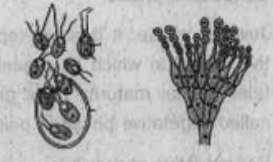 02:15View Solution
02:15View SolutionThe chromosome number in the melocyte of housefly is 12 and that of its gamete is 6. Write the reason for the change in chromosome number of meiocycle and gamete.
03:55View SolutionIn coconut , male and female flowers are separate. Write the term for the male and female flowers.Write the condition of the flowers.
01:59View SolutionObserve the figures given below.Identify the gametes in Aand B. Justify your answer.
 02:33View Solution
02:33View SolutionMatch the following items of column A with B.
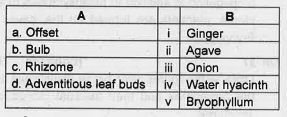 04:26View Solution
04:26View SolutionAnalyse the table given below and fill in the blanks.
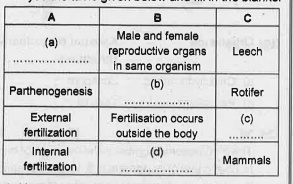 02:45View Solution
02:45View SolutionThe chances of survival of young ones is greater in viviparous organisms than oviparous organisms. Justify this statement.
03:06View SolutionIn some organisms male and female reproductive organs are seen in the same individual. Name that condition.Give two example of such organisms.
01:09View SolutionName of certain plants and their vegetative propagules are given below. Make correct pairs using them.
potato, ginger, bryophyllum, water hyacinth, agave. offset, bulbil, eyes, rhizome, leafbud03:29View SolutionGametogenesis and gamete transfer are the two prefertilization events. Write the differences between the two.
02:22View SolutionBased on the nature of reproduction, organisms are classified as continuous breeders and seasonal breeders. Write the difference between the two.
02:15View SolutionObserve the relationship between the first two terms and fill in the blanks.
a) Hydra : Bud :………………..: Gemmule
b) Birds: Internal fertilization : ………………..External fertilization.03:52View SolutionFertilisation in some organisms occur outside the body.Name that kind of fertilization. Write its disadvantages.
05:47View SolutionThe offspring formed by asexual reproduction is refefrred to as clone.Justify this statement.
02:42View SolutionDuring sexual reproduction fertilization is an important process.But in most aquatic organisms like fishes,amphibians etc.external fertilization occur.In most terrestrial organisms internal fertilization is common.
Point out the differences between external and internal fertilization.02:40View SolutionDuring sexual reproduction fertilization is an important process.But in most aquatic organisms like fishes,amphibians etc.external fertilization occur.In most terrestrial organisms internal fertilization is common.
Point out the differences between external and internal fertilization.02:40View SolutionWrite technical terms for the following.
a) Morphologically different types of gametes.
b) Process of formation of male and female gametes.
c) Formation of new organisms without fertilization.02:04View SolutionFill up the blanks after reading the statement.
Post-fertilization events in angiosperms.
Zygote : Embryo
Ovule : _____
Ovary : _____02:13View SolutionGiven below are 3 gametes a , b and c. a and b gametes undergoes fusion.
a)identify the fusion.
b) Give the explanation for the identification.02:30View SolutionRaman is learning the post fertilization changes of an angiosperm embryo sac with the help of slides. He identified the egg nucleus and polar nuclei in the central cell with the help of his teacher. Name the other nuclei present in the embryo sac.
02:12View SolutionFind out which of the statement are ture.
1)Ovary develops into fruit. 2)In flowering plants, zygote is formed outside the ovule. 3)Ovules develops into fruit. 4)Zygote develops into embryo03:01View SolutionFarmers are propagating plants using vegetative structures .Can you mention the name of any two such structures?
02:01View SolutionPre-fertilization events of sexual reproduction in all organisms are gametogenesis and gamete transfer. What are post-fertilization events?
04:50View SolutionYou are asked to plant ginger in your home. Which part of ginger will you plant? Name the type of reproduction.
02:08View SolutionIn asexual reproduction, offspring are produced by a single parent with or without the involvement of gamete formation. Name the asexual reproductive structures (a & b) given below.
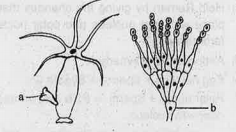 02:06View Solution
02:06View SolutionZoospores are common asexual reproductive structures in plants and animals with relatively simple organisation. Name two other asexual reproductive structures seen in the group.
03:01View SolutionIn honeybees and some lizards, female gamete undergoes development to form new organisms without fertilization. This phenomenon is called _____.
02:30View SolutionMorphologically and genetically similar individuals are called
02:06View SolutionMatch the following terms with regard to vegetative reproduction in plants.
 02:09View Solution
02:09View SolutionAmoeba asexually multiplies by binary fission whereas sponge by……..
02:12View SolutionWater-hyacinth vegetatively multiples by offset : agave by……
01:43View SolutionMatch the Column A and B:
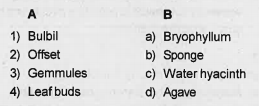 02:56View Solution
02:56View SolutionYeast asexually multiples by budding whereas Penicillium by.
01:46View SolutionBryophyllum vegetatively multiples by adventitious buds where , water hyacinth by____
01:49View SolutionThe chromosome number of oninon is 16 (2n).Find the chromosome number in the following cells with reasons.
EndospermView SolutionThe chromosome number of oninon is 16 (2n).Find the chromosome number in the following cells with reasons.
ZygoteView SolutionWhen a gamete without any fusion develop into a new organisms the phenomenon is called
01:57View SolutionA unisexual flower having no androecium is called
00:45View SolutionSelect the one which is not helping vegetative propagation.
Bulb
Clone
Adventitious buds
Eyes of potato02:48View Solution
EXERCISE questions and complete solutions for chapter REPRODUCTION IN ORGANISM of MAXIMUM PUBLICATION of Class 12
